flat tire HYUNDAI I20 2021 Owners Manual
[x] Cancel search | Manufacturer: HYUNDAI, Model Year: 2021, Model line: I20, Model: HYUNDAI I20 2021Pages: 444, PDF Size: 8.93 MB
Page 28 of 444
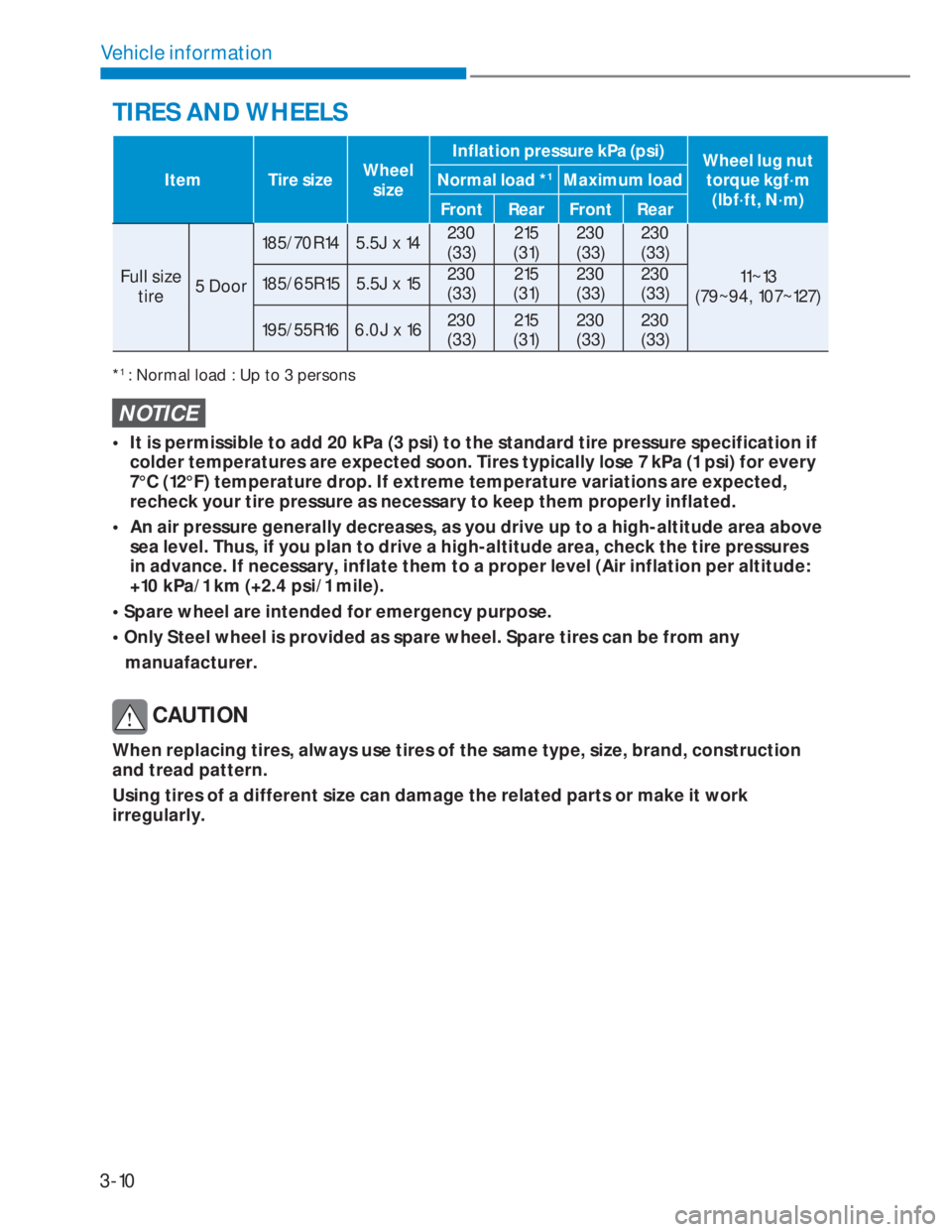
3-10
Vehicle information
TIRES AND WHEELS
Item Tire sizeWheel
sizeInflation pressure kPa (psi)
Wheel lug nut
torque kgf·m
(lbf·ft, N·m) Normal load *1Maximum load
Front Rear Front Rear
Full size
tire5 Door185/70R14 5.5J x 14230
(33)215
(31)230
(33)230
(33)
11~13
(79~94, 107~127) 185/65R15 5.5J x 15230
(33)215
(31)230
(33)230
(33)
195/55R16 6.0J x 16230
(33)215
(31)230
(33)230
(33)
NOTICE
• It is permissible to add 20 kPa (3 psi) to the standard tire pressure specification if
colder temperatures are expected soon. Tires typically lose 7 kPa (1 psi) for every
7°C (12°F) temperature drop. If extreme temperature variations are expected,
recheck your tire pressure as necessary to keep them properly inflated.
• An air pressure generally decreases, as you drive up to a high-altitude area above
sea level. Thus, if you plan to drive a high-altitude area, check the tire pressures
in advance. If necessary, inflate them to a proper level (Air inflation per altitude:
+10 kPa/1 km (+2.4 psi/1 mile).
• Spare wheel are intended for emergency purpose.
• Only Steel wheel is provided as spare wheel. Spare tires can be from any
manuafacturer.
CAUTION
When replacing tires, always use tires of the same type, size, brand, construction
and tread pattern.
Using tires of a different size can damage the related parts or make it work
irregularly.
*1 : Normal load : Up to 3 persons
Page 108 of 444
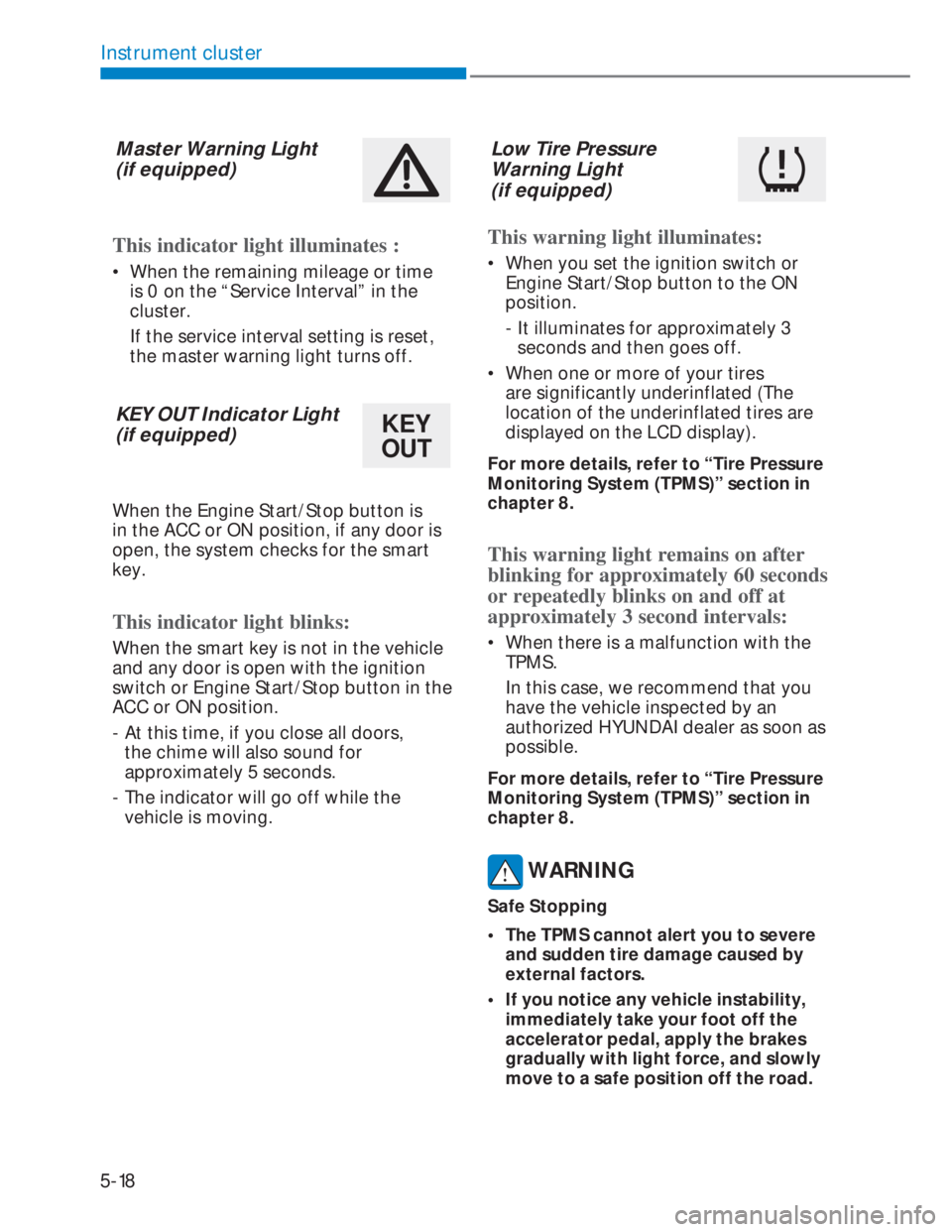
5-18
Instrument cluster
Master Warning Light
(if equipped)
This indicator light illuminates :
• When the remaining mileage or time
is 0 on the “Service Interval” in the
cluster.
If the service interval setting is reset,
the master warning light turns off.
KEY OUT Indicator Light
(if equipped)
KEY
OUT
When the Engine Start/Stop button is
in the ACC or ON position, if any door is
open, the system checks for the smart
key.
This indicator light blinks:
When the smart key is not in the vehicle
and any door is open with the ignition
switch or Engine Start/Stop button in the
ACC or ON position.
- At this time, if you close all doors,
the chime will also sound for
approximately 5 seconds.
- The indicator will go off while the
vehicle is moving.
Low Tire Pressure
Warning Light
(if equipped)
This warning light illuminates:
• When you set the ignition switch or
Engine Start/Stop button to the ON
position.
- It illuminates for approximately 3
seconds and then goes off.
• When one or more of your tires
are significantly underinflated (The
location of the underinflated tires are
displayed on the LCD display).
For more details, refer to “Tire Pressure
Monitoring System (TPMS)” section in
chapter 8.
This warning light remains on after
blinking for approximately 60 seconds
or repeatedly blinks on and off at
approximately 3 second intervals:
• When there is a malfunction with the
TPMS.
In this case, we recommend that you
have the vehicle inspected by an
authorized HYUNDAI dealer as soon as
possible.
For more details, refer to “Tire Pressure
Monitoring System (TPMS)” section in
chapter 8.
WARNING
Safe Stopping
• The TPMS cannot alert you to severe
and sudden tire damage caused by
external factors.
• If you notice any vehicle instability,
immediately take your foot off the
accelerator pedal, apply the brakes
gradually with light force, and slowly
move to a safe position off the road.
Page 151 of 444
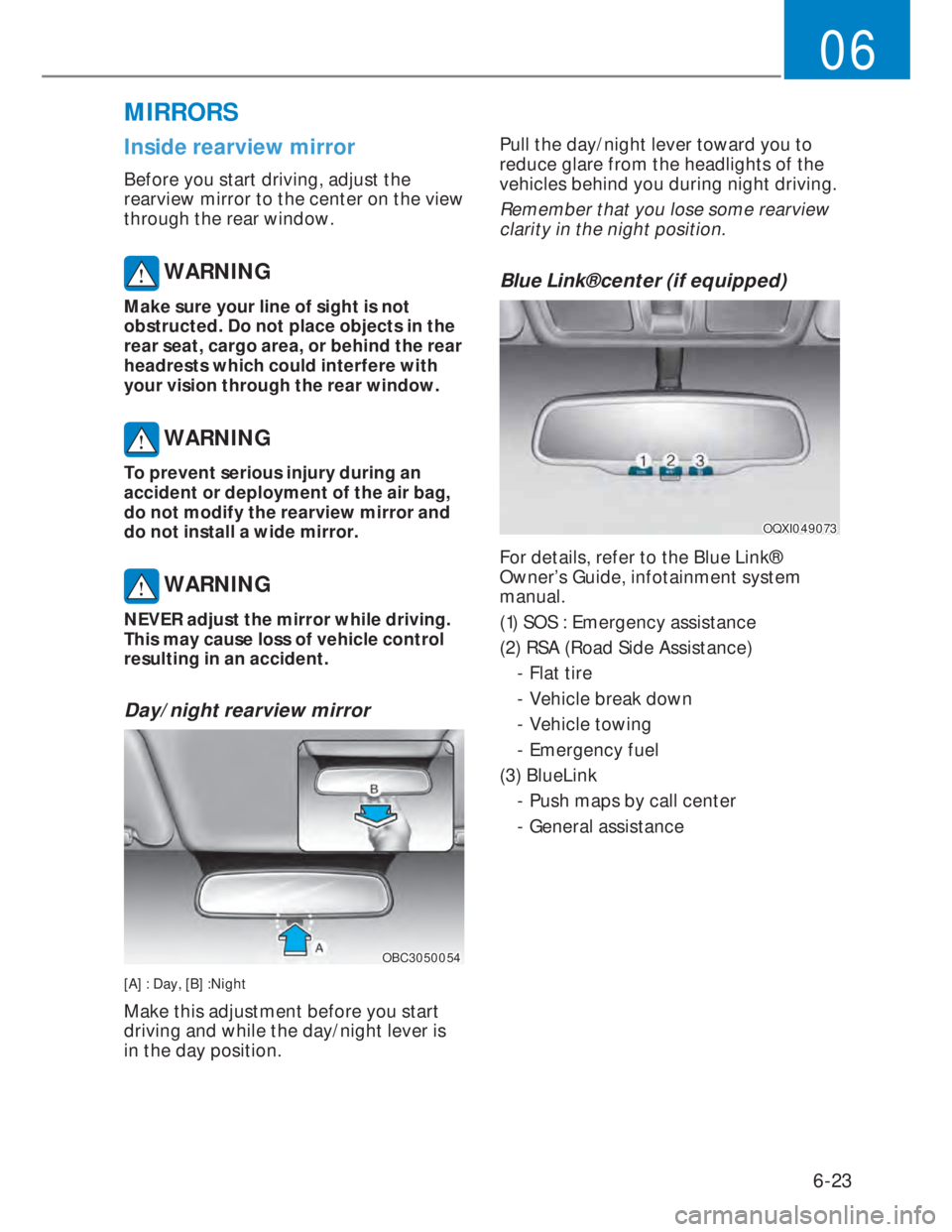
6-23
06
Inside rearview mirror
Before you start driving, adjust the
rearview mirror to the center on the view
through the rear window.
WARNING
Make sure your line of sight is not
obstructed. Do not place objects in the
rear seat, cargo area, or behind the rear
headrests which could interfere with
your vision through the rear window.
WARNING
To prevent serious injury during an
accident or deployment of the air bag,
do not modify the rearview mirror and
do not install a wide mirror.
WARNING
NEVER adjust the mirror while driving.
This may cause loss of vehicle control
resulting in an accident.
Day/night rearview mirror
OBC3050054OBC3050054
[A] : Day, [B] :Night
Make this adjustment before you start
driving and while the day/night lever is
in the day position.Pull the day/night lever toward you to
reduce glare from the headlights of the
vehicles behind you during night driving.
Remember that you lose some rearview
clarity in the night position.
Blue Link® center (if equipped)
OQXI049073OQXI049073
For details, refer to the Blue Link®
Owner’s Guide, infotainment system
manual.
(1) SOS : Emergency assistance
(2) RSA (Road Side Assistance)
- Flat tire
- Vehicle break down
- Vehicle towing
- Emergency fuel
(3) BlueLink
- Push maps by call center
- General assistance
MIRRORS
Page 291 of 444
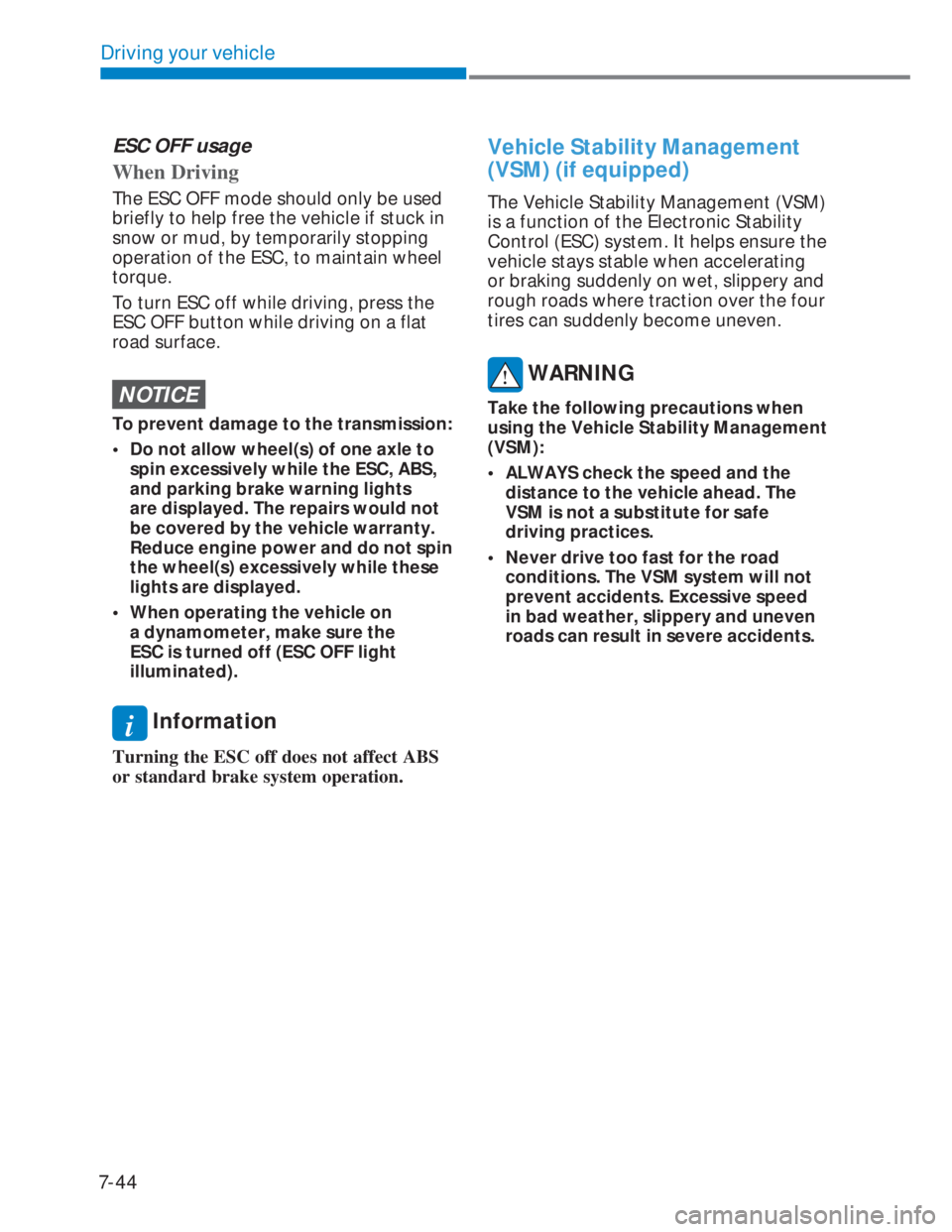
7-44
Driving your vehicle
ESC OFF usage
When Driving
The ESC OFF mode should only be used
briefly to help free the vehicle if stuck in
snow or mud, by temporarily stopping
operation of the ESC, to maintain wheel
torque.
To turn ESC off while driving, press the
ESC OFF button while driving on a flat
road surface.
NOTICE
To prevent damage to the transmission:
• Do not allow wheel(s) of one axle to
spin excessively while the ESC, ABS,
and parking brake warning lights
are displayed. The repairs would not
be covered by the vehicle warranty.
Reduce engine power and do not spin
the wheel(s) excessively while these
lights are displayed.
• When operating the vehicle on
a dynamometer, make sure the
ESC is turned off (ESC OFF light
illuminated).
i Information
Turning the ESC off does not affect ABS
or standard brake system operation.
Vehicle Stability Management
(VSM) (if equipped)
The Vehicle Stability Management (VSM)
is a function of the Electronic Stability
Control (ESC) system. It helps ensure the
vehicle stays stable when accelerating
or braking suddenly on wet, slippery and
rough roads where traction over the four
tires can suddenly become uneven.
WARNING
Take the following precautions when
using the Vehicle Stability Management
(VSM):
• ALWAYS check the speed and the
distance to the vehicle ahead. The
VSM is not a substitute for safe
driving practices.
• Never drive too fast for the road
conditions. The VSM system will not
prevent accidents. Excessive speed
in bad weather, slippery and uneven
roads can result in severe accidents.
Page 294 of 444

7-47
07
If a tire goes flat while you are driving,
apply the brakes gently and keep the
vehicle pointed straight ahead while you
slow down. When you are moving slowly
enough for it to be safe to do so, pull off
the road and stop in a safe location.
Keep your foot firmly on the brake pedal
when the vehicle is stopped to prevent
the vehicle from rolling forward.
Page 315 of 444
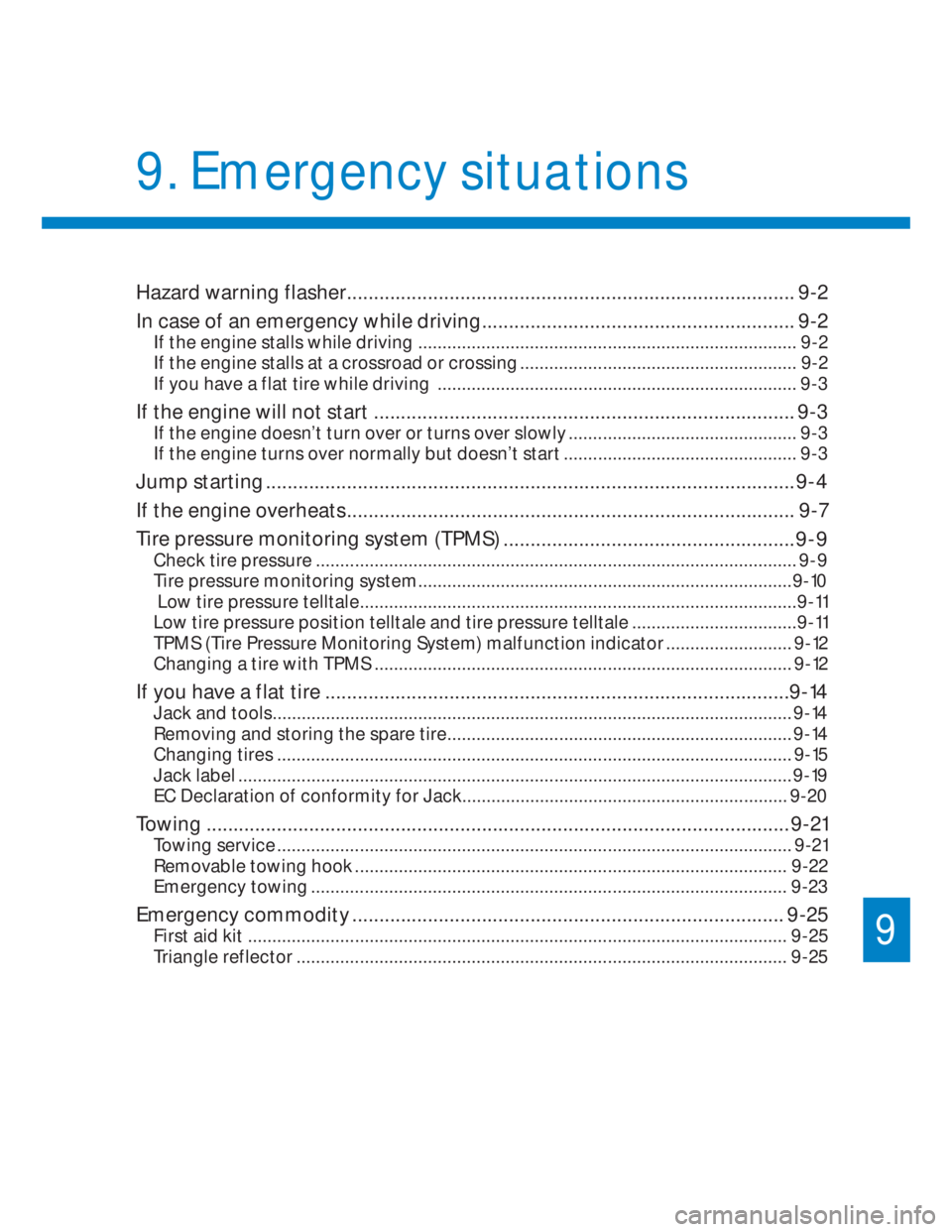
Hazard warning flasher................................................................................... 9-2
In case of an emergency while driving
.......................................................... 9-2
If the engine stalls while driving .............................................................................. 9-2
If the engine stalls at a crossroad or crossing ......................................................... 9-2
If you have a flat tire while driving
.......................................................................... 9-3
If the engine will not start .............................................................................. 9-3
If the engine doesn’t turn over or turns over slowly ............................................... 9-3
If the engine turns over normally but doesn’t start ................................................ 9-3
Jump starting .................................................................................................. 9-4
If the engine overheats
................................................................................... 9-7
Tire pressure monitoring system (TPMS)
......................................................9-9
Check tire pressure ................................................................................................... 9-9
Tire pressure monitoring system .............................................................................9-10
Low tire pressure telltale..........................................................................................9-11
Low tire pressure position telltale and tire pressure telltale
..................................9-11
TPMS (Tire Pressure Monitoring System) malfunction indicator
.......................... 9-12
Changing a tire with TPMS ...................................................................................... 9-12
If you have a flat tire ......................................................................................9-14
Jack and tools........................................................................................................... 9-14
Removing and storing the spare tire....................................................................... 9-14
Changing tires
.......................................................................................................... 9-15
Jack label .................................................................................................................. 9-19
EC Declaration of conformity for Jack................................................................... 9-20
Towing ............................................................................................................ 9-21
Towing service .......................................................................................................... 9-21
Removable towing hook ......................................................................................... 9-22
Emergency towing .................................................................................................. 9-23
Emergency commodity ................................................................................ 9-25
First aid kit ............................................................................................................... 9-25
Triangle reflector ..................................................................................................... 9-25
9. Emergency situations
9
Page 317 of 444
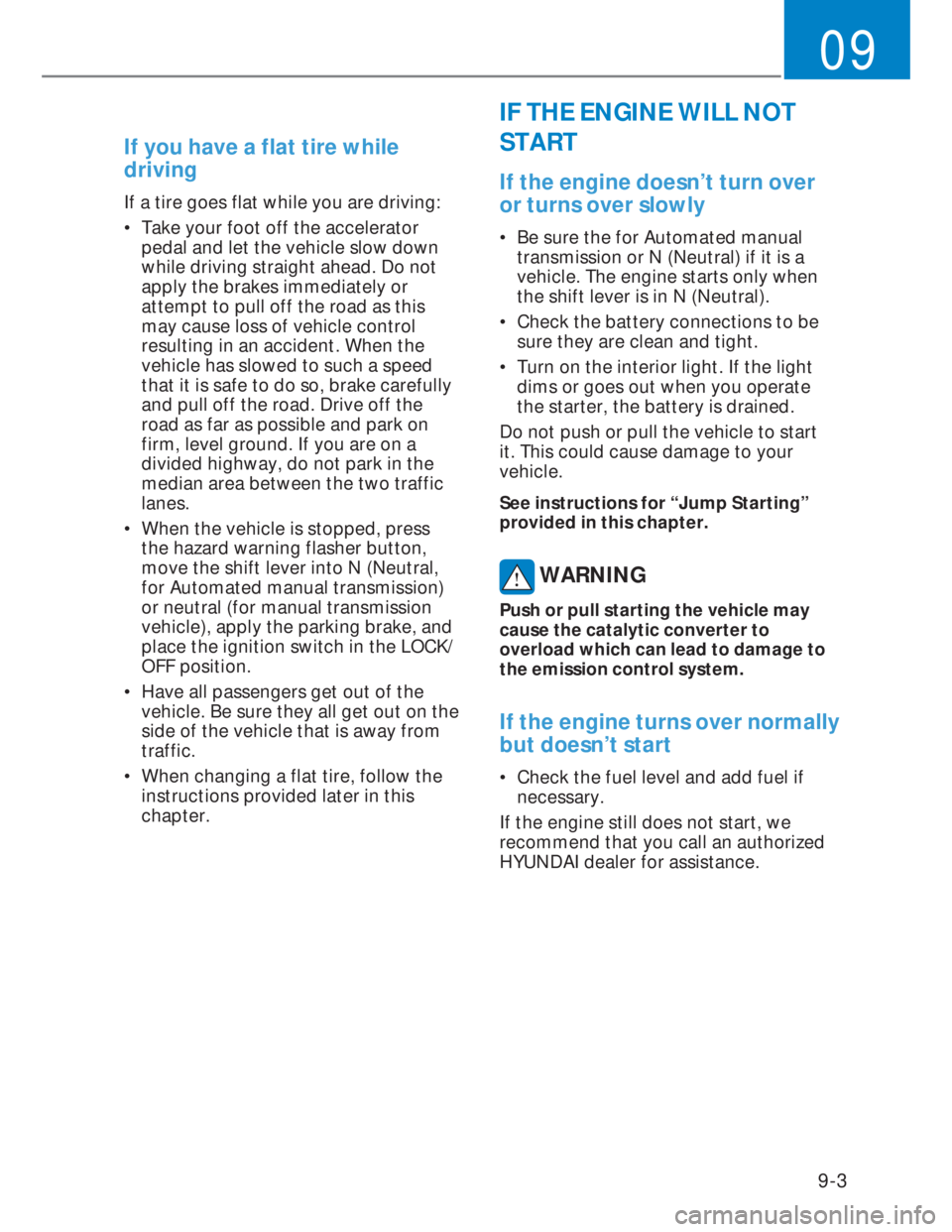
9-3
09
If you have a flat tire while
driving
If a tire goes flat while you are driving:
• Take your foot off the accelerator
pedal and let the vehicle slow down
while driving straight ahead. Do not
apply the brakes immediately or
attempt to pull off the road as this
may cause loss of vehicle control
resulting in an accident. When the
vehicle has slowed to such a speed
that it is safe to do so, brake carefully
and pull off the road. Drive off the
road as far as possible and park on
firm, level ground. If you are on a
divided highway, do not park in the
median area between the two traffic
lanes.
• When the vehicle is stopped, press
the hazard warning flasher button,
move the shift lever into N (Neutral,
for Automated manual transmission)
or neutral (for manual transmission
vehicle), apply the parking brake, and
place the ignition switch in the LOCK/
OFF position.
• Have all passengers get out of the
vehicle. Be sure they all get out on the
side of the vehicle that is away from
traffic.
• When changing a flat tire, follow the
instructions provided later in this
chapter.
IF THE ENGINE WILL NOT
START
If the engine doesn’t turn over
or turns over slowly
• Be sure the for Automated manual
transmission or N (Neutral) if it is a
vehicle. The engine starts only when
the shift lever is in N (Neutral).
• Check the battery connections to be
sure they are clean and tight.
• Turn on the interior light. If the light
dims or goes out when you operate
the starter, the battery is drained.
Do not push or pull the vehicle to start
it. This could cause damage to your
vehicle.
See instructions for “Jump Starting”
provided in this chapter.
WARNING
Push or pull starting the vehicle may
cause the catalytic converter to
overload which can lead to damage to
the emission control system.
If the engine turns over normally
but doesn’t start
• Check the fuel level and add fuel if
necessary.
If the engine still does not start, we
recommend that you call an authorized
HYUNDAI dealer for assistance.
Page 324 of 444
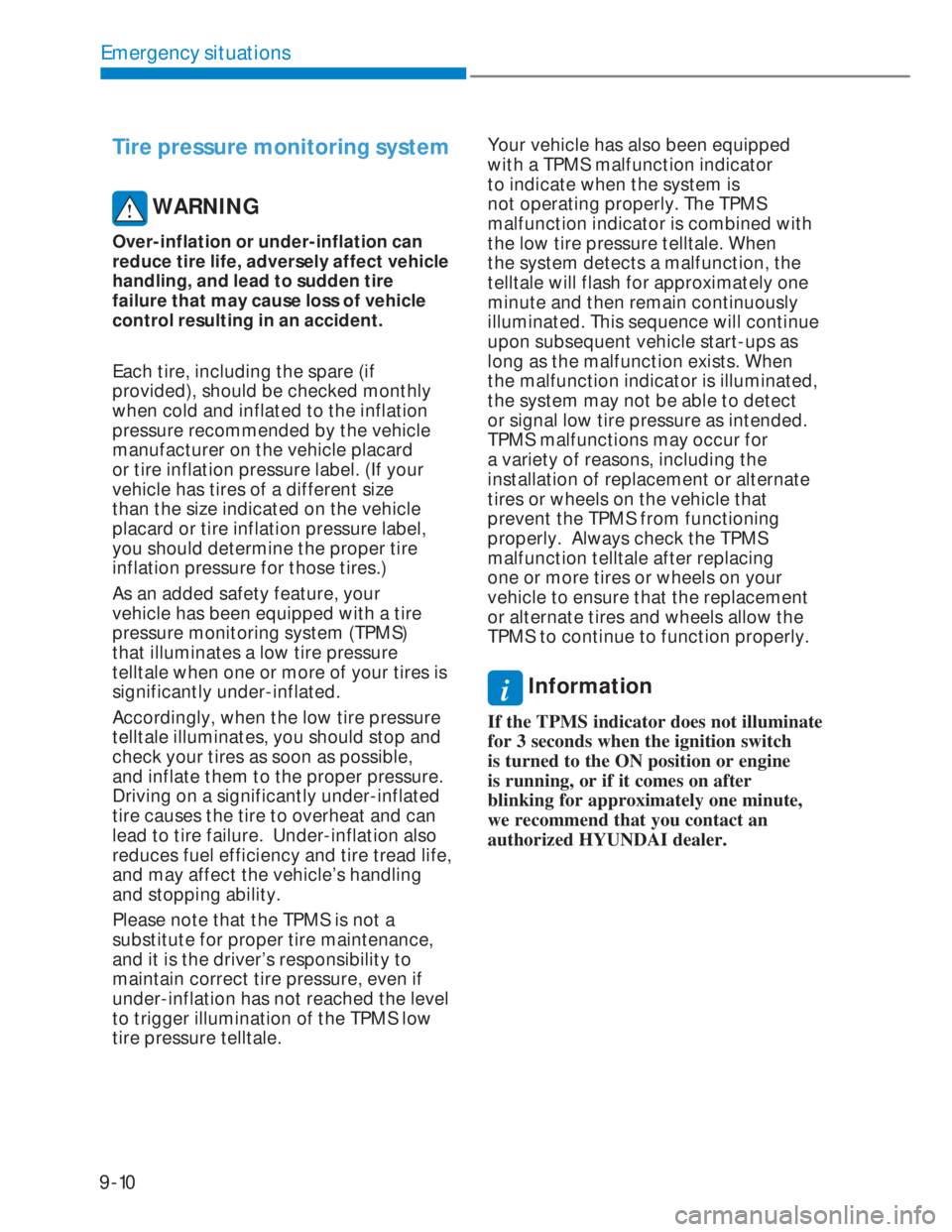
9-10
Emergency situations
Tire pressure monitoring system
WARNING
Over-inflation or under-inflation can
reduce tire life, adversely affect vehicle
handling, and lead to sudden tire
failure that may cause loss of vehicle
control resulting in an accident.
Each tire, including the spare (if
provided), should be checked monthly
when cold and inflated to the inflation
pressure recommended by the vehicle
manufacturer on the vehicle placard
or tire inflation pressure label. (If your
vehicle has tires of a different size
than the size indicated on the vehicle
placard or tire inflation pressure label,
you should determine the proper tire
inflation pressure for those tires.)
As an added safety feature, your
vehicle has been equipped with a tire
pressure monitoring system (TPMS)
that illuminates a low tire pressure
telltale when one or more of your tires is
significantly under-inflated.
Accordingly, when the low tire pressure
telltale illuminates, you should stop and
check your tires as soon as possible,
and inflate them to the proper pressure.
Driving on a significantly under-inflated
tire causes the tire to overheat and can
lead to tire failure. Under-inflation also
reduces fuel efficiency and tire tread life,
and may affect the vehicle’s handling
and stopping ability.
Please note that the TPMS is not a
substitute for proper tire maintenance,
and it is the driver’s responsibility to
maintain correct tire pressure, even if
under-inflation has not reached the level
to trigger illumination of the TPMS low
tire pressure telltale.Your vehicle has also been equipped
with a TPMS malfunction indicator
to indicate when the system is
not operating properly. The TPMS
malfunction indicator is combined with
the low tire pressure telltale. When
the system detects a malfunction, the
telltale will flash for approximately one
minute and then remain continuously
illuminated. This sequence will continue
upon subsequent vehicle start-ups as
long as the malfunction exists. When
the malfunction indicator is illuminated,
the system may not be able to detect
or signal low tire pressure as intended.
TPMS malfunctions may occur for
a variety of reasons, including the
installation of replacement or alternate
tires or wheels on the vehicle that
prevent the TPMS from functioning
properly. Always check the TPMS
malfunction telltale after replacing
one or more tires or wheels on your
vehicle to ensure that the replacement
or alternate tires and wheels allow the
TPMS to continue to function properly.
i Information
If the TPMS indicator does not illuminate
for 3 seconds when the ignition switch
is turned to the ON position or engine
is running, or if it comes on after
blinking for approximately one minute,
we recommend that you contact an
authorized HYUNDAI dealer.
Page 325 of 444
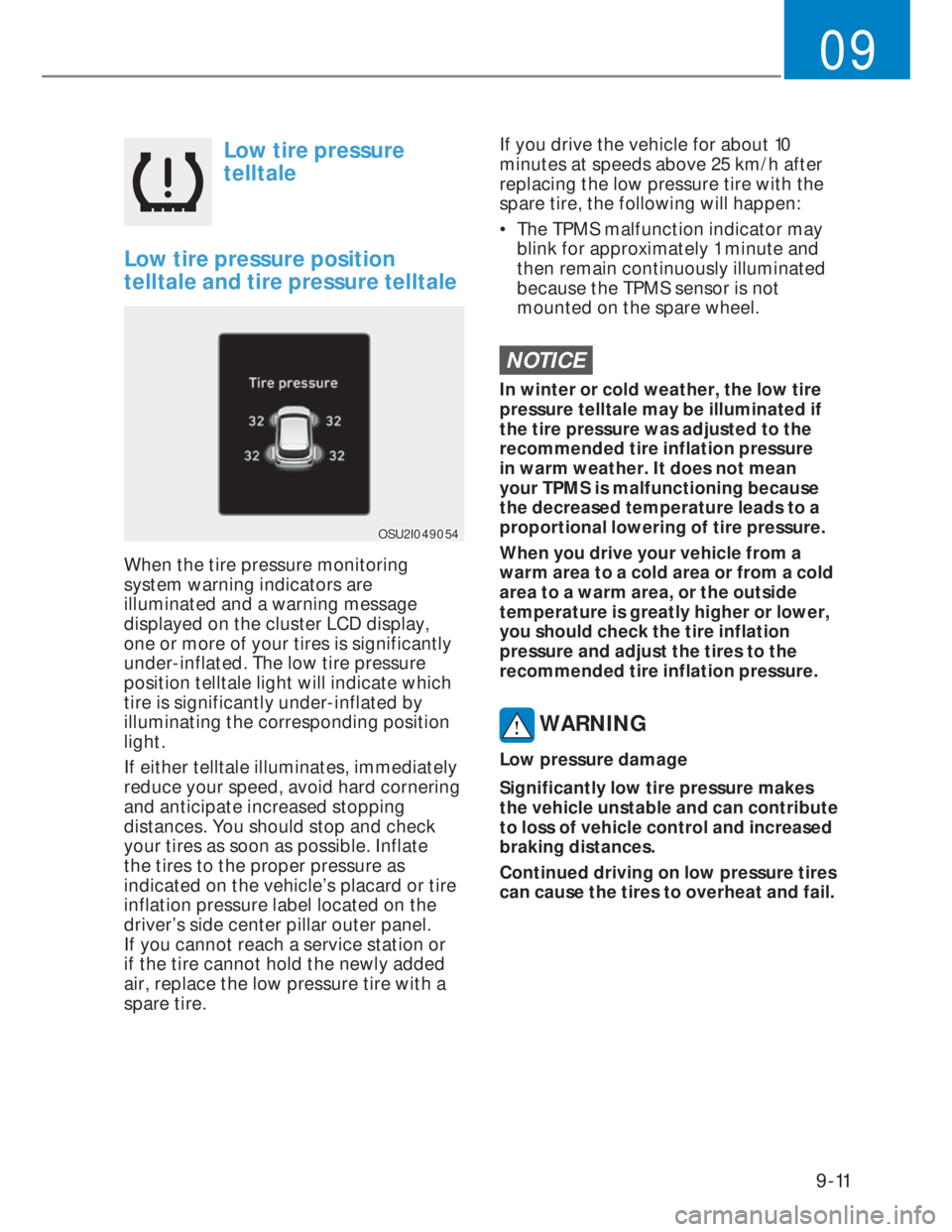
9-11
09
Low tire pressure
telltale
Low tire pressure position
telltale and tire pressure telltale
OSU2I049054OSU2I049054
When the tire pressure monitoring
system warning indicators are
illuminated and a warning message
displayed on the cluster LCD display,
one or more of your tires is significantly
under-inflated. The low tire pressure
position telltale light will indicate which
tire is significantly under-inflated by
illuminating the corresponding position
light.
If either telltale illuminates, immediately
reduce your speed, avoid hard cornering
and anticipate increased stopping
distances. You should stop and check
your tires as soon as possible. Inflate
the tires to the proper pressure as
indicated on the vehicle’s placard or tire
inflation pressure label located on the
driver’s side center pillar outer panel.
If you cannot reach a service station or
if the tire cannot hold the newly added
air, replace the low pressure tire with a
spare tire.
If you drive the vehicle for about 10
minutes at speeds above 25 km/h after
replacing the low pressure tire with the
spare tire, the following will happen:
• The TPMS malfunction indicator may
blink for approximately 1 minute and
then remain continuously illuminated
because the TPMS sensor is not
mounted on the spare wheel.
NOTICE
In winter or cold weather, the low tire
pressure telltale may be illuminated if
the tire pressure was adjusted to the
recommended tire inflation pressure
in warm weather. It does not mean
your TPMS is malfunctioning because
the decreased temperature leads to a
proportional lowering of tire pressure.
When you drive your vehicle from a
warm area to a cold area or from a cold
area to a warm area, or the outside
temperature is greatly higher or lower,
you should check the tire inflation
pressure and adjust the tires to the
recommended tire inflation pressure.
WARNING
Low pressure damage
Significantly low tire pressure makes
the vehicle unstable and can contribute
to loss of vehicle control and increased
braking distances.
Continued driving on low pressure tires
can cause the tires to overheat and fail.
Page 326 of 444
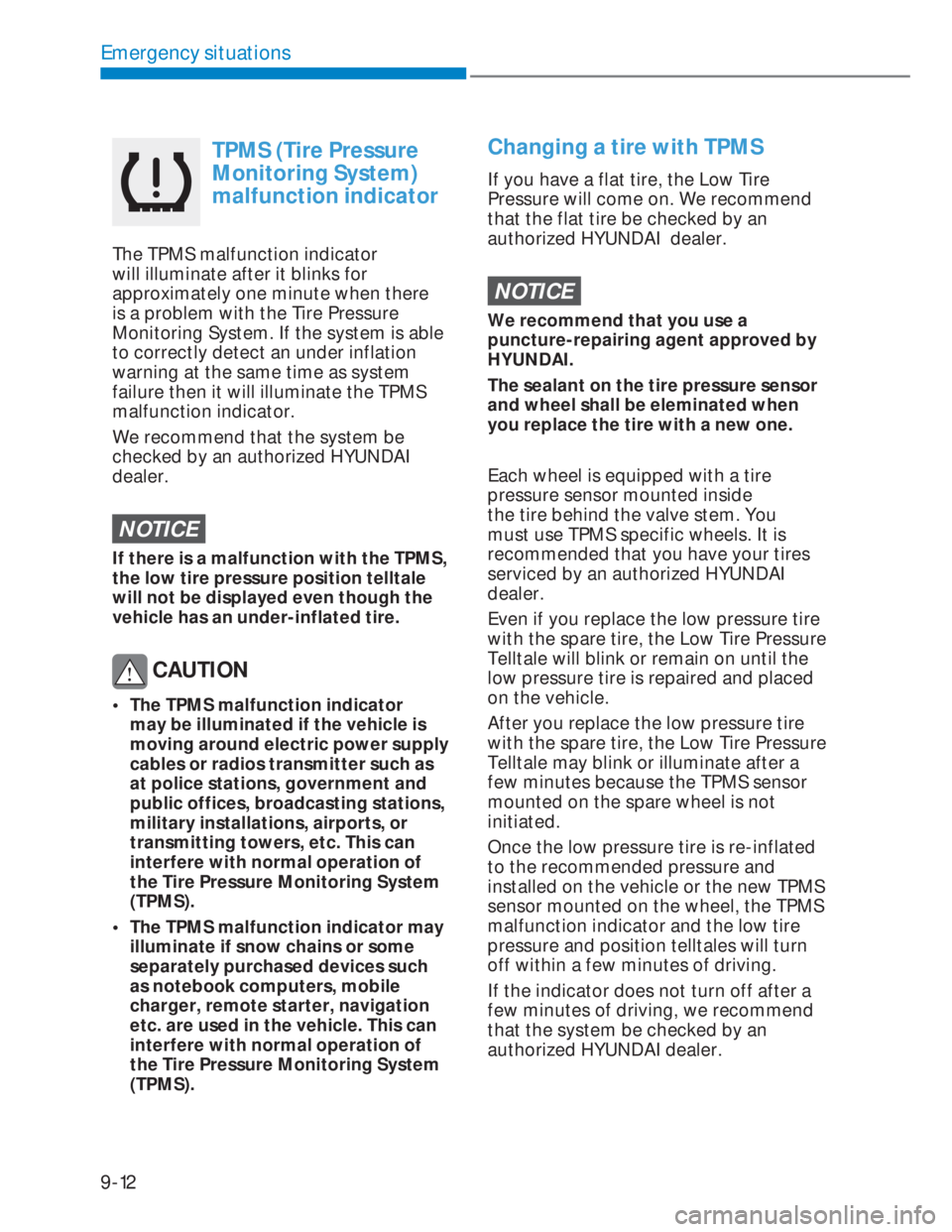
9-12
Emergency situations
TPMS (Tire Pressure
Monitoring System)
malfunction indicator
The TPMS malfunction indicator
will illuminate after it blinks for
approximately one minute when there
is a problem with the Tire Pressure
Monitoring System. If the system is able
to correctly detect an under inflation
warning at the same time as system
failure then it will illuminate the TPMS
malfunction indicator.
We recommend that the system be
checked by an authorized HYUNDAI
dealer.
NOTICE
If there is a malfunction with the TPMS,
the low tire pressure position telltale
will not be displayed even though the
vehicle has an under-inflated tire.
CAUTION
• The TPMS malfunction indicator
may be illuminated if the vehicle is
moving around electric power supply
cables or radios transmitter such as
at police stations, government and
public offices, broadcasting stations,
military installations, airports, or
transmitting towers, etc. This can
interfere with normal operation of
the Tire Pressure Monitoring System
(TPMS).
• The TPMS malfunction indicator may
illuminate if snow chains or some
separately purchased devices such
as notebook computers, mobile
charger, remote starter, navigation
etc. are used in the vehicle. This can
interfere with normal operation of
the Tire Pressure Monitoring System
(TPMS).
Changing a tire with TPMS
If you have a flat tire, the Low Tire
Pressure will come on. We recommend
that the flat tire be checked by an
authorized HYUNDAI dealer.
NOTICE
We recommend that you use a
puncture-repairing agent approved by
HYUNDAI.
The sealant on the tire pressure sensor
and wheel shall be eleminated when
you replace the tire with a new one.
Each wheel is equipped with a tire
pressure sensor mounted inside
the tire behind the valve stem. You
must use TPMS specific wheels. It is
recommended that you have your tires
serviced by an authorized HYUNDAI
dealer.
Even if you replace the low pressure tire
with the spare tire, the Low Tire Pressure
Telltale will blink or remain on until the
low pressure tire is repaired and placed
on the vehicle.
After you replace the low pressure tire
with the spare tire, the Low Tire Pressure
Telltale may blink or illuminate after a
few minutes because the TPMS sensor
mounted on the spare wheel is not
initiated.
Once the low pressure tire is re-inflated
to the recommended pressure and
installed on the vehicle or the new TPMS
sensor mounted on the wheel, the TPMS
malfunction indicator and the low tire
pressure and position telltales will turn
off within a few minutes of driving.
If the indicator does not turn off after a
few minutes of driving, we recommend
that the system be checked by an
authorized HYUNDAI dealer.